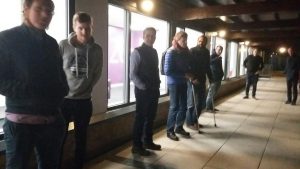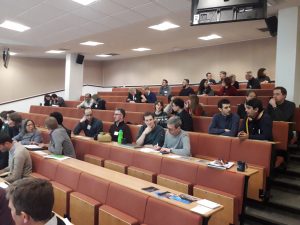 Flexibility Reading Rooms
Flexibility Reading Rooms
The reading rooms provide a chance for around 15 participants to discuss a paper, shorter notes and/or snippets of data – on the topic in hand. These discussions will be recorded and made available as podcasts online.
5th Reading Room : Space, time and contestations over demand response and infrastructure access
Wednesday 17th March 2021, 12.00-15.00 UK time
This extended Reading Room, was designed as a collaboration with Mikko Jalas and colleagues to bring together a small group of researchers interested in discussing rhythmicity and access to infrastructure services such as energy, water and transport. In broad terms, the Reading Room considered themes of temporality; (energy) justice and the availability of infrastructure services. More specifically, it explored the idea of infrastructure services as spatio-temporal landscapes and considered how, under peak loads or other difficult-to-serve situations/locations, access to services might be regulated, as well as the conflicts which arise in relation to regulation.
The event was part of an ongoing collaboration between the CREDS flexibility theme and Mikko Jalas, Aalto University, Department of Design, and is linked to a project entitled “Rhythms of Infrastructure Services” (submitted to the Academy of Finland) that is set to examine demand management and the rhythmicity of rail and electricity infrastructure services.
Programme
Each session consisted of a 20 minute presentation followed by 15 minutes of discussion.
12:00-12:35 Session 1: Mikko Jalas and Sini Numminen (Aalto University, Department of Design): “Prime-time Access for whom? Emerging Rhythms of Consumption of Electricity and Road Infrastructures”
Break (5 min)
12:40-13:15 Session 2: Ibo van de Poel, (TU Delft, Department of Values, Technology and Innovation): “Equal access to infrastructure services? The importance of value and time”
Break (10 min)
13:25-14:00 Session 3: Udo Pesch, (TU Delft, Department of Values, Technology and Innovation): “Energy justice and controversies: Formal and informal assessment in energy projects”
Break (10 min)
14:10-14:45 Session 4: Eva Heiskanen, Jenny Rinkinen, Kaisa Matschoss and Eeva-Lotta Apajalahti (University of Helsinki, Centre for Consumer Society Research): “Electrification and flexibility: opportunities, tensions and alternatives”
15:00 End of seminar
You can listen to the recording here:
4th Reading Room : Flexibility Capital
20th January 2021, 12.30-14.00 UK Time
The January ‘Flexibility’ Reading Room focused on a short ‘Perspective’ piece by Gareth Powells and Michael Fell (2019) ‘Flexibility capital and flexibility justice in smart energy systems’, Energy Research and Social Science. This provided a starting point from which to discuss different ways of conceptualising flexibility. We considered, in no particular order, questions about Bourdieu’s notion of capital; the historical positioning of whatever we mean by flexibility; how flexibility is a product of shifting assemblages and/or a property of people; what it means to measure flexibility; what regulators and engineers might take from Gareth and Mike’s paper, the relevance of distinguishing between storage, the ability to ramp up and down provision, and other possible ‘bases’ of flexibility, along with also fundamental questions about the implicit backdrop of normality. This was a relatively small Reading Room which meant we had lots of time to get into these and other questions in some depth.
You can listen to the recording here:
3rd Reading Room : Forms of adaptation and their limits
16th December 2020,12:00-13:30 UK Time
Background
Part of the remit of the Flexibility Theme is to recognise that energy demands are always changing and that people and organisations are constantly adapting and responding to events – whether these relate to the ‘needs’ of a more intermittent energy supply system or not. These strategies provide insight into the apparent ‘limits’ of adaptation and into definitions of core service and baselines.
The Reading Room on the 16 December 2020 focused on these questions. In particular, we considered examples of what organisations (companies/businesses) take to be the limits of adaptation –what are the non-negotiable practices implicit in contingency plans, in everyday forms of buffering and storage, and in methods of managing and handling disruptions of one kind or another?
Buffering
Where do buffer zones ‘lie’ in different systems of provision and organisation? Where is there ‘slack’, how is this built in, and how is it related to peaks, tensions and pressures. How do different combinations or configurations of buffering impact on energy/transport demand? How are local contingencies and responses interconnected across and beyond organisations? For example, where are opportunities for ‘buffering’ situated across extended supply chains and how do they vary in response to socio-temporal cycles (e.g. seasons, holidays)? How might webs of inter-organisational contingency and flexibility be identified at the level of an entire sector, and how could we plot their consequences for energy demand at this scale?
Storage
Storing and stock piling represents one method of coping with anticipated disruption. How are forms of storing, waiting, and prioritising organised in different sectors? For example, how have ‘just in time’ strategies affected the scale and location of ‘stock piles’ of energy, and related or assumed patterns of mobility? How do methods and scales of storage – especially of fuels-but also energy e.g. in the form of hot water – relate to such features as cost, weight, volume or the importance of back up and reserve? In aggregate, what do these arrangements mean for the ‘flexibility’ of energy systems and the capacity to shift the timing of demand?
Resilience
Organisations regularly adjust to changing events in the world. Some of these events disrupt ‘normal’ patterns of ‘service’ and energy demand – generating increases, or sometimes decreases in consumption. At the same time, many methods of managing uncertainties are about flattening the impact of unexpected or anticipated disruption: ensuring ‘the same’ outcome and the same activities and practices, despite fluctuations in supply, or in how things are done. Responses suppose a kind of ‘normal’ baseline provision or point of reference. We know that these change over time but how, why and with what effect on the flexibility of the energy system over all.
We are interested in how contingency planning has changed as new ways of living and doing (practices) emerge and as anticipated forms of disruption change as well. Wars, viruses, climate change itself present different sorts of challenges, over various time scales. In such contexts, how do exceptional responses become normal, and does this lead to new forms of (in)flexibility and demand?
We had short introductions from:
- Stanley Blue – on storage
- Greg Marsden – on transport disruption, resilience and (possibly) Covid-19.
We used these introductions as input for our discussions on the following questions:
- What is the significance of contingency and contingency planning for understanding flexibility and the possibilities for demand side management (e.g. in organisations or households)?
- What does contingency planning involve? How is it made through forms of temporal buffering and storage e.g. of energy, goods, etc.)?
- How are possibilities for contingency made? And what is the relationship between contingency planning ‘normal’ business? Does extreme planning escalate what counts as ‘normal’ provision? How could we tell?
- What do all of the above strategies reveal about the scope for flexible adaptation in energy demand?
You can listen to the recording here:
2nd Reading Room : Seasonality
1st October 2020, 12:30-14:00 UK time
The Flexibility Reading Room did not actually read anything on seasonality (partly because we could not find anything suitable. If anyone out there has any suggestions, do let us know). Instead we had four short presentations on the topic; one from Mikko Jalas on infrastructures, variations in demand and the ‘shadowy’ sides of these arrangements; one from Elizabeth Shove, who did a quick summary of what seem to be relevant ideas from Marcel Mauss’ work on seasonality amongst the Eskimos; Dale Southerton and Jen Whillans on looking for seasonal variations in UK time use data and Jacopo Torriti, taking a similar approach to energy and time use data.
We then went around the ‘room’ which was quite crowded – some 18 people, from a splendid range of different disciplines and countries. Hearing about which ideas caught the attention and sparked interest from each person in turn resulted in a powerful sense of potential: in different ways and from different angles topics of seasonality are here to stay.
There was so much going on here – as you will discover if you listen to the recording – that we will almost certainly have to return to this topic in the future. In the meantime, welcome to autumn.
You can listen to the recording here:
1st Reading Room : Conceptualising Flexibility
28th July 2020, 12:30-14:00 UK time
The Flexibility team was joined by an interdisciplinary group (engineers, physicists, social scientists) from around the world (Norway, Germany, Italy, Switzerland, and Japan) to discuss a recently published article by Stanley Blue, Elizabeth Shove, and Peter Forman in Time and Society Conceptualising Flexibility: Challenging Representations of Time and Society in the Energy Sector.
You can listen to the recording here:
The discussion explored different ideas arising from the article.
One theme was the relational status of the concepts of fixity and flexibility, and how the meaning of these terms changes depending on what is being described, and from what point of view. For example, while meal times might appear more flexible that they were 50 years ago, the sequences of activities in which they are set has remained relatively fixed. While a given practice appears flexible when compared to a given time-slot, its position can be quite fixed within one or more sequences of practices.
We also discussed the possibility of capturing, describing, and measuring flexibility in society when it is described in emergent and complex terms. Is this a hopeless task or not? Opinions differed.
Related to this we talked about what methods might be used to capture aspects of sequencing, synchronisation, and therefore of flexibility, for example with time-use data, by or by somehow measuring the strengthening and weakening of ties and links between practices. What could be captured described by measuring variation, change over time, extended sequences, and the effects of repetition?
The paper by Blue et al. ends by challenging experts in the energy sector to engage with more fundamental insights from social scientific studies of time – and especially with ideas about the temporal constitution of society and energy demand. The editor for Time and Society, Michelle Bastian, who also joined the session, invited people working on time and temporality to engage with issues relating to the energy sector and the environment more generally.
Previous Events
Journal of Energy History: Special issue on Flexibility meeting
9th-10th January 2020, Lancaster University:here you can find the results of an exercise in Picturing Flexibility

CREDS Whole Centre Workshop on Time and Flexibility
16th – 17th September 2019, Lancaster University.
Inspiring document/Background paper

A summary in the form of a collection of postcards
More pictures from the workshop
Flexibility Team Meetings
Flexibility team meeting: Abingdon, December 2019
Pictures from Oxford and Abingdon
Flexibility team meeting: Matlock, April 2019
Summary of Readings
DEMAND/Flexibility theme workshop



